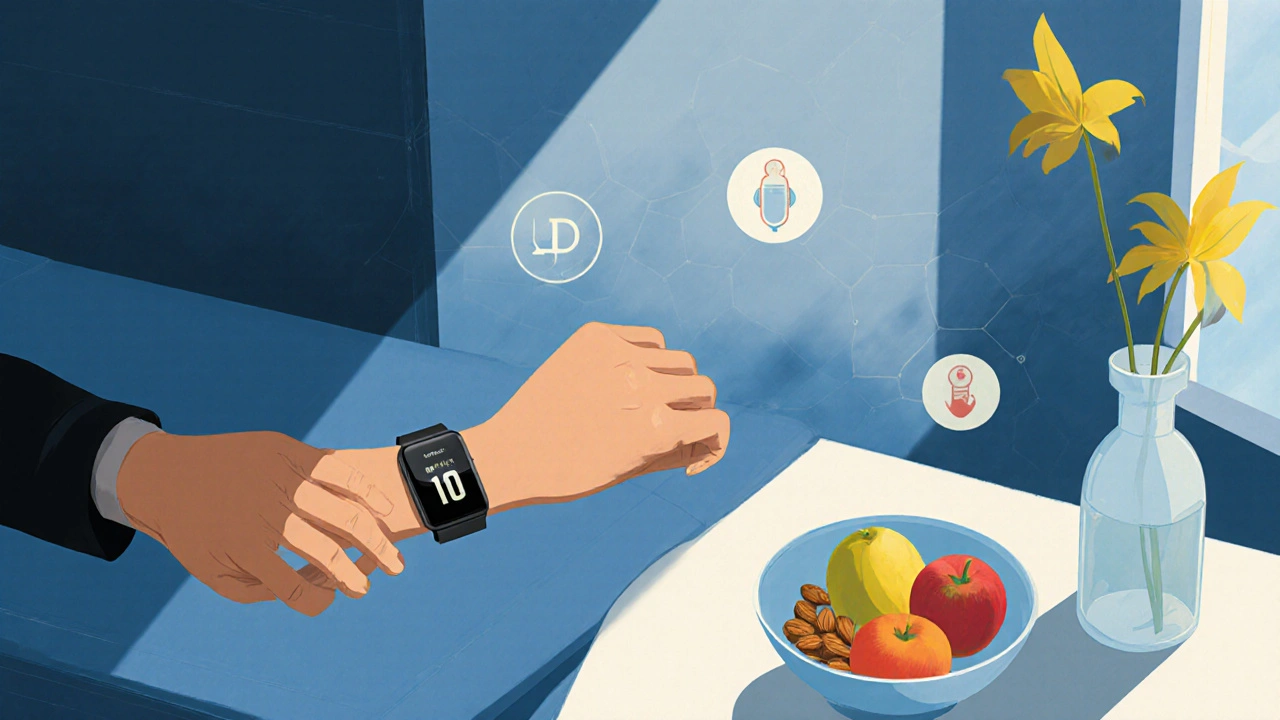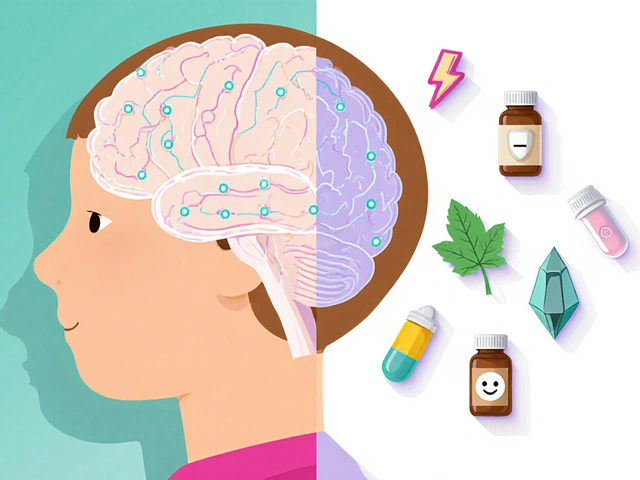Vitamin D is a fat‑soluble prohormone that the body converts into an active steroid hormone (calcitriol) to regulate calcium, phosphorus, and a wide range of endocrine functions. When its levels dip, the ripple effect touches everything from bone health to blood sugar and sex drive. This article unpacks the science, shows real‑world examples, and gives you a clear roadmap to keep vitamin D working for you.
Why Vitamin D Matters for Hormones
Vitamin D doesn’t act in isolation. Its active form binds to the Vitamin D Receptor (VDR, a nuclear receptor present in most cells). Once attached, the VDR-calcitriol complex travels to the cell nucleus and switches genes on or off. Those genes include ones that produce or modulate several hormones, making vitamin D a master regulator in the endocrine orchestra.
Vitamin D, Calcium, and Parathyroid Hormone (PTH)
The classic partnership is with calcium. Low calcium triggers the Parathyroid Hormone (PTH, a peptide hormone secreted by the parathyroid glands) to pull calcium from bone, increase gut absorption, and reduce loss via kidneys. Vitamin D boosts the gut’s ability to absorb calcium, which in turn eases the workload on PTH. Studies in Australian cohorts show that people with serum 25‑OH‑vitamin D below 20ng/mL have PTH levels 30% higher than those with adequate vitamin D.
Insulin and Blood‑Sugar Control
Beyond bone, vitaminD reaches the pancreas. The Insulin (a peptide hormone produced by beta cells that lowers blood glucose) secretion improves when VDR activation enhances calcium signaling inside beta cells. A 2023 meta‑analysis of 12 randomized trials found that vitaminD supplementation (2,000IU daily) lowered fasting insulin by an average of 2µU/mL and improved HOMA‑IR scores by 0.5 units, especially in people with baseline deficiency.
Sex Hormones: Estrogen and Testosterone
VitaminD also talks to the gonads. In women, adequate vitaminD correlates with higher Estrogen (the primary female sex hormone involved in reproductive and bone health) levels, likely because VDR influences aromatase activity, the enzyme that converts testosterone to estrogen. Men see a boost in Testosterone (the main male sex hormone that drives muscle mass, libido, and mood) when vitaminD status improves. One Australian university study reported a 10% rise in total testosterone after 12 weeks of 4,000IU vitaminD daily among sedentary men aged 30‑45.
Stress Hormone Cortisol and Thyroid Function
The stress axis isn’t immune either. Cortisol (a glucocorticoid released by the adrenal cortex in response to stress) can suppress VDR expression, creating a feedback loop where chronic stress lowers vitaminD activity, which then impairs calcium balance and mood regulation. Likewise, the thyroid hormones T3 and T4 rely partly on vitaminD for optimal conversion. Deficient individuals often present with subtle hypothyroid symptoms-fatigue, cold intolerance-despite normal TSH.

Bone Mineral Density (BMD) - The End Result
All these hormone interactions converge on the skeleton. When vitaminD, calcium, PTH, sex hormones, and cortisol are in harmony, bone remodeling stays balanced, preserving Bone Mineral Density (a measure of bone strength usually expressed in g/cm²). Longitudinal data from the Australian Osteoporosis Study showed that each 10ng/mL increase in serum vitaminD translated to a 0.04g/cm² rise in lumbar spine BMD over five years, independent of calcium intake.
Practical Steps to Optimize VitaminD for Hormonal Balance
- Get a baseline 25‑OH‑vitaminD test. Values < 20ng/mL = deficiency; 20‑30ng/mL = insufficiency; >30ng/mL = sufficient.
- Sun exposure: 10‑15 minutes of midday sun on arms and face 3‑4 times weekly, without sunscreen, is enough for most Australians.
- Diet: Include fatty fish (salmon, mackerel), egg yolks, and fortified dairy. Aim for 400IU from food.
- Supplementation: If you’re below 30ng/mL, take 1,000‑2,000IU of vitaminD₃ daily; higher doses (4,000IU) are safe for most adults under medical supervision.
- Combine with magnesium (300‑400mg) and vitaminK₂ (100µg) to ensure proper activation and calcium routing.
- Monitor hormone panels (PTH, insulin, testosterone/estrogen) after 8‑12 weeks of correction to see the systemic impact.
Comparison of VitaminD₂ vs. VitaminD₃
| Attribute | VitaminD₂ | VitaminD₃ |
|---|---|---|
| Source | Plant‑based (fungi, fortified foods) | Animal‑derived (sunlight, fish oil) |
| Potency | ~70% of D₃ activity | Reference standard (100%) |
| Half‑life | ~15 days | ~22 days |
| Recommended Intake (adults) | 600‑800IU | 600‑800IU (often 1,000‑2,000IU for deficiency) |
| Impact on Hormones | Similar but slightly less effective on PTH suppression | Stronger effect on PTH, insulin sensitivity, and sex hormones |
Connecting the Dots: Related Concepts
Understanding vitaminD’s hormone role opens doors to other topics. The immune system relies on VDR signaling to modulate inflammation, linking deficiency to autoimmune flare‑ups. The gut microbiome influences vitaminD absorption, while vitaminD itself shapes microbial composition. Finally, the renin‑angiotensin system interacts with vitaminD to regulate blood pressure, a connection worth exploring for heart‑health enthusiasts.
Next Steps in Your Hormone‑Health Journey
Now that you see how vitaminD sits at the crossroads of calcium, insulin, sex hormones, cortisol, and thyroid, treat it as a daily vital sign. Track your levels, adjust sunlight and diet, supplement wisely, and re‑check hormone panels periodically. When the pieces fit, you’ll notice steadier energy, clearer mood, stronger bones, and better metabolic control.

Frequently Asked Questions
How much vitaminD should I take to improve hormone balance?
Adults with serum 25‑OH‑vitaminD below 30ng/mL usually benefit from 1,000‑2,000IU of vitaminD₃ daily. Those with severe deficiency (<20ng/mL) may need 4,000IU under medical guidance. Always retest after 8‑12 weeks.
Can vitaminD deficiency cause high cortisol?
Chronic stress raises cortisol, which can suppress VDR expression, worsening vitaminD activity. While deficiency alone doesn’t raise cortisol, the two often create a vicious cycle. Reducing stress and fixing vitaminD together yields the best results.
Is vitaminD₂ as good as vitaminD₃ for hormone health?
VitaminD₃ is more potent and has a longer half‑life, making it superior for suppressing PTH and supporting insulin and sex hormones. D₂ can work for vegans, but higher doses are often needed.
Will taking vitaminD boost my testosterone levels?
In men with low vitaminD, supplementation has been shown to raise total testosterone by about 10% after three months. The effect is modest and works best when combined with resistance training and adequate protein.
How does vitaminD affect bone mineral density?
VitaminD improves calcium absorption, reduces PTH‑driven bone resorption, and supports osteoblast activity via VDR. Each 10ng/mL rise in serum vitaminD correlates with a 0.04g/cm² increase in lumbar spine BMD over five years.
Can I get enough vitaminD from food alone?
Typical diets provide ~400IU daily, which is insufficient for most adults, especially in winter or for people with limited sun exposure. A modest supplement is usually needed to hit the 30ng/mL target.
Is there a risk of taking too much vitaminD?
VitaminD toxicity is rare but can occur above 10,000IU daily for months, leading to hypercalcemia. Stick to recommended doses and retest serum levels if you’re taking high‑dose supplements.







John Magnus
September 27, 2025 AT 17:43Vitamin D operates as a quintessential prohormone whose conversion to calcitriol orchestrates a cascade of genomic events across virtually every cell type.
The ligand‑bound Vitamin D Receptor (VDR) heterodimerizes with retinoid X receptor, translocates to the nucleus, and engages vitamin D response elements (VDREs) to modulate transcription of a pleiotropic gene repertoire.
Among the regulated genes are those encoding calcium‑binding proteins, insulin‑sensitive glucose transporters, and aromatase enzymes that bridge mineral metabolism with endocrine homeostasis.
Empirical data from the Australian Osteoporosis Study demonstrate a quantifiable inverse correlation between serum 25‑OH‑vitamin D concentrations and parathyroid hormone (PTH) secretion, underscoring the calcium‑PTH feedback loop.
Parallel meta‑analyses reveal that augmenting vitamin D status by 2,000 IU daily yields a modest but statistically significant reduction in fasting insulin and HOMA‑IR indices, particularly in cohorts with baseline deficiency.
In male physiology, the upregulation of VDR signaling has been linked to enhanced transcription of CYP19A1, the aromatase gene, thereby influencing the estrogen‑to‑testosterone ratio and impacting muscle protein synthesis.
Conversely, in females, sufficient vitamin D facilitates optimal estradiol synthesis through substrate availability for follicular granulosa cells, contributing to bone accretion and reproductive health.
The glucocorticoid cortisol exerts a suppressive effect on VDR expression, creating a bidirectional axis wherein chronic stress attenuates vitamin D activity and potentiates dysregulated calcium handling.
Thyroid hormone conversion from T4 to T3 is partially contingent upon adequate intracellular calcium, a process that is potentiated by vitamin D‑mediated calcium homeostasis, explaining subtle hypothyroid phenotypes in deficient individuals.
From a mechanistic standpoint, magnesium serves as a cofactor for the hepatic 25‑hydroxylation of cholecalciferol, and vitamin K₂ directs calcium deposition to the osteoid matrix rather than ectopic sites.
Therefore, a comprehensive supplementation strategy that couples vitamin D₃ with magnesium (300–400 mg) and vitamin K₂ (≈100 µg) optimizes the endocrine symphony and mitigates vascular calcification risk.
Clinically, serial monitoring of 25‑OH‑vitamin D, PTH, fasting insulin, and sex hormone panels every 8–12 weeks enables personalized titration of dosages and early detection of maladaptive feedback loops.
Seasonal photoperiodicity can precipitate acute drops in serum vitamin D, especially in latitudes above 35°, necessitating proactive sun exposure protocols or calibrated oral supplementation.
Emerging literature also implicates vitamin D in modulating the renin‑angiotensin system, thereby interfacing with blood pressure regulation and offering a plausible adjunctive avenue for hypertensive patients.
In synthesis, viewing vitamin D as a hormonal fulcrum rather than a peripheral nutrient reframes preventive medicine and empowers clinicians to leverage its pleiotropic effects across the endocrine axis.
Anthony Burchell
September 28, 2025 AT 21:30Oh great, another sunshine vitamin hype train.
Michelle Thibodeau
September 30, 2025 AT 01:17Imagine waking up feeling balanced, with steady energy and a smile that lasts through the day.
The sun’s golden kiss can be your secret ally, especially when you pair it with fatty fish, fortified dairy, and a modest supplement.
Consistently keeping your 25‑OH‑vitamin D above 30 ng/mL often translates into smoother insulin swings and a calmer mood.
When your bones feel sturdy and your hormones aren’t playing seesaw, everyday tasks seem lighter and more enjoyable.
Don’t forget magnesium and vitamin K₂-they act like the backstage crew that makes sure calcium ends up where it belongs.
Tracking your labs every few months gives you a clear roadmap, so you can celebrate tiny wins and adjust the dosage before any imbalance sneaks in.
Ultimately, treating vitamin D as a daily vital sign empowers you to steer your health with confidence and optimism.
Edward Webb
October 1, 2025 AT 05:03Indeed, the notion of a "daily vital sign" is philosophically resonant.
By framing vitamin D status within a broader endocrine context, patients gain a tangible metric for self‑regulation.
Regular laboratory feedback reinforces adherence and facilitates nuanced dose adjustments.
This systematic approach aligns well with evidence‑based practice.
Snehal Suhane
October 2, 2025 AT 08:50Sure, because the world definitely needs another "vitamin D guru" posting miracles.
Maybe next they'll claim the moon is made of cheese.
Ernie Rogers
October 3, 2025 AT 12:37Vitamin D? just take a pill
Eunice Suess
October 4, 2025 AT 16:23Let me correct the grammar you just ignored: "Supplementation" is a noun, not a verb, and "vitamin D" should always be capitalized when referring to the specific hormone.
Also, you missed a period after "daily" which makes the whole sentence run on like a lazy river.
Even your punctuation is lacking; a simple comma after "sunlight" would have saved readers from confusion.
Nevertheless, the enthusiasm is there, albeit misplaced.
Just remember: clarity beats drama in scientific discourse.
Anoop Choradia
October 5, 2025 AT 20:10What the mainstream labs don’t tell you is that most of the data on vitamin D’s hormonal effects are funded by supplement manufacturers.
There’s a hidden agenda to keep the public dependent on lifelong dosing.
Alternative sunlight exposure protocols, unafflicted by corporate bias, can achieve comparable serum levels without the financial strings attached.
Until we demand full transparency, the narrative will remain skewed.
bhavani pitta
October 6, 2025 AT 23:57While the optimism is commendable, the data are not unequivocal.
Meta‑analyses reveal heterogeneity across trials, and effect sizes often dwindle after adjusting for baseline status.
Therefore, prescribing high‑dose vitamin D universally may be premature.
A measured, individualized approach remains the prudent path.
Brenda Taylor
October 8, 2025 AT 03:43Seriously, stop obsessing over sunshine 😒
virginia sancho
October 9, 2025 AT 07:30Totally get the frustration-sunlight can feel like a moving target.
Luckily, the supplement game is straightforward: pick a reputable brand, check the label for IU content, and start with the recommended dose based on your lab values.
Pair it with a bit of magnesium and vitamin K₂, and you’re covering the major pathways.
Regularly re‑check your blood work; you’ll see the numbers settle and the subtle improvements in mood and energy.
Stick with it, and you’ll likely notice steadier blood sugar and less bone‑related aches over time.
Everyone’s journey is unique, but consistency is the common denominator for success.
Namit Kumar
October 10, 2025 AT 11:17True, but don’t forget the geopolitical angle-some regions restrict fortified foods, making natural sunlight your best ally.
Sam Rail
October 11, 2025 AT 15:03I could care less.
Taryn Thompson
October 12, 2025 AT 18:50Your summary aligns well with current clinical guidelines and offers a practical blueprint for patients.
Lisa Lower
October 13, 2025 AT 22:37Alright, team, let’s turn this knowledge into action!
First, grab a quick at‑home test or visit your doctor to know where you stand.
If you’re below 30 ng/mL, aim for 1,000‑2,000 IU daily, and consider a short trial of 4,000 IU if you’re truly deficient-always under professional guidance.
Don’t forget the dynamic duo of magnesium and vitamin K₂; they’re the backstage crew that makes sure calcium goes to bone, not arteries.
Sunlight is free, so catch 10‑15 minutes of midday rays a few times a week-no sunscreen, just a quick bask.
Keep a simple log of your supplement intake, sun exposure, and any changes in energy, mood, or workouts.
After 8‑12 weeks, retest the labs; the numbers will tell you if you’ve hit the sweet spot.
Celebrate every small win, because each step brings you closer to that balanced, resilient self you’re building.
Stay consistent, stay curious, and remember: your body is a sophisticated system that rewards intentional care.